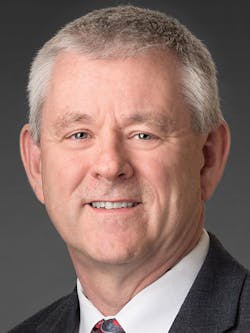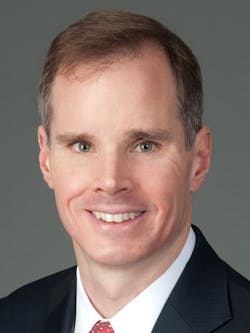During a pandemic that motivates a panicked public to pursue recommended personal protective equipment (PPE) and disinfecting/sanitizing products in droves, Supply Chain professionals struggle to maintain optimal inventory levels within their healthcare organizations, recalling a pivotal scene in the 1998 Pixar film, “A Bug’s Life.”
While Supply Chain arguably resembled the organized and regimented ant colony to a degree, the public whipped into a buying frenzy by swarms of media reports and politician press conferences, acting more like the grasshopper clan.
The outcome? A grave situation that made traditional historical concerns about backorders, substitutions and recalls seem … quaint.
This has led and continues to lead Supply Chain and all of those they service – which, by the way, includes everyone – to ask some fundamental questions.
Where did we – and everything (presumably the supply chain) – go wrong? How did we – and everything – go south so quickly? Why? But perhaps the key concern lingering and looming on the minds of administrators and clinicians alike is what are we going to do about it so that this doesn’t happen the next time?
What are some ways to maintain and buttress inventory levels, track what you store where and when it’s used and then predict what’s needed to satisfy demand?
And what should doctors, nurses and infection preventionists reasonably expect of Supply Chain and vice versa?
System vs. Individual failure?
Clinical and Supply Chain experts wrestle with the notion that the COVID-19-induced product shortages resulted from a system failure or a radical behavior shift by consumers that reacted too desperately and too quickly for the system to catch up and keep pace.
“I have been a member of the [Alabama] State’s Healthcare Coalition for many years. Emergency Management for pandemics and disasters is not a new topic of discussion,” said Pate, who has extensive experience in infection prevention and environmental safety. “Plans, as well as disaster response, have been addressed for many years with meticulous attention given to stockpiles and mitigation for epidemics and natural disasters. It is very likely that people didn’t expect that a pandemic with the magnitude of COVID-19 would ever occur. This pandemic has similar characteristics to SARS in the past, but the spread and lack of containment with COVID-19 has been much more widespread.”
COVID-19 has proven to be nothing short of an administrative, clinical, financial and operational back-breaker that blew up existing modeling, based on the butterfly effect.
“Many hospitals and healthcare organizations have planned for natural disasters, but it is extremely impossible to plan for a pandemic such as COVID-19 and prevent critical [shortages]. “Stockpiles in the State Health Departments didn’t have the capacity to address the needs. The national stockpile was also not prepared for this type of pandemic.
“Consumers received conflicting information from healthcare authorities regarding wearing masks and how to protect themselves,” Pate continued. “This led to many consumers purchasing and stockpiling supplies and causing a shortage for others, or in contrast, disregarding the guidelines for social distancing and not wearing cloth masks. With the misinformation from authorities, coupled with panic, confusion and non-compliance has occurred.”
“I think it is a combination of all those things as well as a lack of leadership at critical decision points,” Chung determined. “The system was underprepared for the pandemic, but also acted very slowly once it came. I don’t think consumer behavior contributed as much, since consumers merely reacted to misinformation. The major product shortages experienced by healthcare organizations were PPE and N95 masks, and I don’t believe the consumer reaction affected those as much. While masks were in huge demand later, the initial shortage of masks for healthcare providers was not caused by consumers buying them up from Home Depot. Another factor is the slow adoption of mask conservation policies and techniques that caused a lot of waste in the beginning. Clinical validation of appropriate PPE use was also slow, so there was a lot of overutilization in the beginning.”
But Mark Campbell, FACHE, CMRP, Vice President, Supply Chain, Tampa General Hospital, points to several factors as shortage culprits.
“The global supply chain operates [just-in-time] with no room for spikes in demand,” he said. “There is limited visibility into the product pipeline leading to panic buying and bidding wars over products that might not even be available. Providers don’t keep adequate supplies on-hand due to financial and/or space constraints. There is limited planning and supply coordination from government leaders at all levels.”
Data access, visibility and government assistance to a degree should make a difference, according to Campbell.
“Distributors need to open their inventory status and share real-time data,” he insisted. “Most of the key PPE products should come through them. This may require higher inventory levels, and cost, for everyone. A locally-owned and managed pandemic supply should be maintained and supplemented with government supplies, where they are allocated based on patient demand.”
“It is very easy for us to look back and start ‘armchair quarterbacking what occurred related to product and equipment shortages associated with COVID-19,” Fennessy said. “When asked, I believe as an industry we performed exceptionally well, and rather than focus on what went wrong I am trying to think about what we could do better. I believe overall the national health system responded about as well as it could have, given how quickly things changed and moved related to the virus.
“In my opinion, if two months before the pandemic hit many of us would have brought forward sourcing requests asking for approval to build stockpiles of PPE at 10 percent to 20 percent of what had been historical levels of activity, the response would have been, ‘what data do you have to support that request?’” he continued. “[This], I believe, is the core issue going forward. We need to develop predictive tools for demand management that are bi-directional between providers and manufacturers that support anticipating demand well in advance of the crisis occurring. Further, those predictive tools have to be directionally accurate. Manufacturers need to trust them in order to anticipate demand and change production schedules.”
Collective confusion
“The shortages were precipitated by the disruptions in manufacturing and logistic operations in China due to the initial coronavirus outbreak,” she observed. “Given the global reliance on products or components from China, this ripple hit most product categories. Couple this with the increased global demand, the shortages were to be expected.
Decision making certainly experienced disruptions.
“Most healthcare providers have pandemic/emergency preparedness teams and plans,” Pakieser continued. “The challenge is which event do you prepare for? Seasonal, environmental events such as a hurricane, manmade disasters like a terrorist attack or naturally-occurring diseases like a viral pandemic? The response and required supplies differ based on the emergency, so our provider colleagues can only prepare as well as their leadership teams direct. Add in the unexpected response of normal citizens exacerbating the supply-demand shortages and quickly consuming additional supplies. In my observation, it was not a system failure as much as an unprecedented spike in demand at a time that the entire system was being taxed. Globally, we needed more PPE than existed at the time.”
“Many of these critical supplies are sold by only two or three companies, and the manufacturing is done in China,” he indicated. “While this method does an excellent job in reducing costs, it does leave the supply chain in a precarious position in the event of a disruption. For example, before COVID-19, the U.S.-China trade dispute was a clear warning sign of potential disruption. While hospitals can continue to purchase these critical supplies from their current supplier, back-up plans are needed, such as creating a relationship with a secondary and/or non-traditional supplier based in the United States.”
Jackson acknowledges that domestic production tends to translate to higher prices.
“I’ve talked to dozens of CFOs and Supply Chain leaders throughout the country, and all are willing to pay a bit more for supplies manufactured in the United States,” he said. “To be clear, they don’t necessarily want the U.S.-based manufacturer to be their primary supplier of these products. However, they would like to create a business relationship with a U.S. manufacturer to be their secondary supplier. The purchase requirements from a secondary supplier are much lower as compared to the primary supplier. CFOs feel they got hit hard financially on the ‘gray’ market for critical supplies. They feel it’s worth paying a small premium to have a U.S.-based secondary supplier.”
“Because of the force of this pandemic, supply chains did not have enough supplies and equipment in inventory to equal the demand,” she said. “The global economy hurt us a bit, too, in that many crucial items needed are made outside of the U.S. – mainly China. We didn’t have a lot of leeway in finding other sources since not many remain in the U.S. I believe everyone in the supply chain is rethinking their emergency-preparedness plans and talking about solutions. I also believe that most health systems are rethinking everything, including architecture, equipment planning, telehealth, priorities and inventory and distributor partnerships to be able to better serve patients in the future.”
Juhas agrees on more diversification of sources and less reliance on certain countries, knowing full well that a lot of products include components made in Asia, so backups for both products and their components should be prominent in any planning.
“The surge in demand was clearly a driving force in upending the healthcare system chain,” he noted. “With a high number of independent supply chains within the U.S. all vying for adequate supplies to support their ‘potential’ patient population, it became quickly apparent that health systems with more sophisticated procurement practices were able to get ahead of the curve.
“Over the years, the healthcare supply chain has successfully utilized an allocation model to manage demand fluctuations more effectively for manufacturers/distributors to ensure the supply chain maintained its integrity,” Redding continued. “With the most recent events, the industry turned into a free-for-all between all parties within the supply chain. There is a need for industry-wide marketplace to systemically monitor demand, sell and manage the flow of goods within the industry. A combination of local, regional and national sourcing strategies are critical to ensure future success in managing the flow of goods to the actual demand point(s).”
“I believe that the product shortages, most specifically but not exclusively PPE SKUs, were the result of a lack of imagination in our industry,” he noted. “PPE is inexpensive and doesn’t take up much space relative to other medical supplies, but we collectively failed to imagine such tremendous, widespread demand until it was too late. Simply put, going forward disaster preparedness by providers and municipal planners needs to be expanded beyond terror, large accidents and extraordinary weather events to include pandemics. Providers need to stock for the anticipated supply needs of caregivers, and cities and communities need to stock for the general public.”
Crossroads of conflict
Two group purchasing organization executives classified the coronavirus pandemic as a “perfect storm” of “unprecedented demand.”
System, meet speedbump.
“Enter a novel virus that no one fully understood how it was transmitted, where it truly originated from and presented with a complicated mixture of symptoms in patients,” Denning continued. “The one thing everyone agreed upon in the early stages was that, at a minimum it was transmitted by respiratory means. This meant that providers were facing an unknown, highly-contagious infection and a panicked public, while trying to determine a rational approach to product usage to deal with manufacturers who could not get their PPE products out of the Asian countries where they were manufactured due to sequestering for in-country use. Virtually overnight, in some of the hardest hit areas, hospitals had used 10 times their usual amount of PPE products. In the pre-COVID industry environment, there was simply no way that the suppliers or providers could have adequately planned for this unprecedented and ongoing spike in demand for PPE. The focus was not just on getting enough PPE supply, but also ensuring the PPE was being used in a judicious manner.”
Denning concentrates on the use of N95 respirators before and after COVID-19 as one example.
“Given the significant barrier protection these respirators provide, their use was limited to surgeries and other high-risk cases before COVID-19,” she indicated. “This meant a minimal number of staff were using them on daily basis on a limited number of patients. For the 3,000-plus hospitals we serve, this translated to an annual usage of about 10 million per year. During COVID-19, the use of these respirators expanded through many more patient interactions and many more staff using them each day. Early indications are that in the next 12 months we will see purchase volumes of these same respirators potentially go beyond one billion. This is a combination of the much broader and more frequent use combined with a need to maintain inventory in reserves in the case of another pandemic of this proportion.”
The global spread of the coronavirus simply overwhelmed the supply chain, observed David Hargraves, Senior Vice President, Supply Chain, Premier Inc.
“COVID-19 introduced unprecedented demand in the global healthcare supply chain, the likes of which we have never seen before,” he said. “Although we have faced isolated spot shortages before in the wake of natural disasters and other health crises in the past, no single state, country, government or manufacturer could have fully prepared for the staggering global surge in demand for critical supplies, in some cases up to 17 times, over a short period of time.
“COVID-19 underscored something that Premier has been saying for a very long time – that we need to be more thoughtful about our supply chain broadly,” Hargraves continued. “When it works, no one thinks about it, but in an outbreak, vulnerabilities are on display. Sixty-eight percent of product disruptions occur due to poor demand-signaling. Premier has been a longstanding and passionate advocate for supply chain diversity and resiliency, taking lessons we’ve learned from disasters and past outbreaks such as Ebola and H1N1 to encourage manufacturers to think more expansively about how they source and supply.”
Hargraves calls for “a more diversified supply chain and balance of the distribution of manufacturing to prevent overreliance on overseas regions for our healthcare.”
Mark Wheeler, Director, Supply Chain Solutions, Zebra Technologies linked the shortages to a rapid shift in demand combined with assumptions about acceptable lead times and manufacturing flexibility that were built into the supply chain. “Many of these assumptions are now under review with the perspective of hindsight and a renewed appreciation for the importance of supply chain visibility and responsiveness,” he added.
“In the early stages of the COVID-19 crisis, we saw surges in healthcare purchasing driven by expected demand and limited access to historical purchasing data for critical equipment parts and supplies,” said David Brennan, Senior Vice President and Chief Product Officer, PartsSource. “Once customers started actively working with PartsSource to ask the right questions and look at the data we were making available to them, the panic was short-lived, and the resiliency of our customers’ supply chain was revealed. PartsSource proactively worked with our suppliers and customers to tackle the immediate challenges and pivot to address future uncertainty.”
Next in this series:
About the Author
Rick Dana Barlow
Senior Editor
Rick Dana Barlow is Senior Editor for Healthcare Purchasing News, an Endeavor Business Media publication. He can be reached at [email protected].










